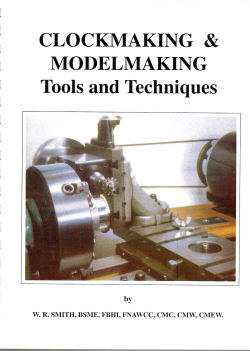Clockmaking & Modelmaking Tools and Techniques
by W R SMITH
I have by no means listed all the subjects dealt with in this book - such as the numerous good "shorties," i.e., resurfacing bench oilstones, a hint for safety in metal spinning, and so on. The book's contents are general enough that I believe any home shop machinist reader or clockmaker will find it a worthwhile addition to his bookshelf. The text is well written, in clear and easy style. Beautifully illustrated with well over 200 photos and dimensioned line drawings, this book is the distillation of shop methods of a master clockmaker's lifelong experiences.

Chapters
1 - The Care and Use of the Graver
2 - Super Glue Arbors for Wheel Cutting in the Bench Lathe
3 - A Length Gauge for In-Barrel Mainsprings
4 - A Fusee Grooving Attachment for the Screw Cutting Bench Lathe
5 - The use of Piercing and Fret Saws For the Clockmaker & Modeler
6 - The Preacher - A remarkable Bushing Tool
7 - A Pinion Head Depthing Tool
8 - A New Type of Filing Button
9 - A Drill for Sheet Metal
10 - Button Centres for the Clock and Model Makers
11 - The Adjusting Rod - A New Look at an Old Tool
12 - A Tripod Extension For Workshop Photography
13 - An Inexpensive 3-Jaw Chuck for the Watch and Clockmaker's Lathe
14 - A Length Transfer Gauge for Spring Barrel Arbors
15 - A Left Hand to Right Hand Duplicator
16 - Hints, Kinks and Dodges
17 - Super Glue to the Rescue
This book
can be obtained from
CLOCKMAKING & MODELMAKING TOOLS AND TECHNIQUES
By W. R. Smith, BSME, FBI II, FNAWCC, CMC
Bill Smith, author of two other books recently reviewed in these pages (How to Make a Grass-Hopper Skeleton Clock and How to Make a Lyre Skeleton Clock), has now brought out a new book that will be of interest to a greater proportion of HSM readers. Bill Smith is a master clockmaker, and his orientation is basically and undeniably clocks, BUT...Clockmaking & Modelmaking Tools and Techniques is most definitely not just for clockmakers. In this new 8-1/2 X 11" soft cover, 1 12-page coil (cirlox) bound book, Mr, Smith has rounded up the best of his previously published articles in the British Horological Journal, Timecraft, Model Engineer, and Horological Journal. He-has revised, expanded and updated them as required, and put them together in book form. Any aspiring clockmaker will find a host of ideas worth many many times the price of the book, but so, too, will the person who only glances at a clock to find out what time it is. Included is an interesting idea for a method of winding coil springs in the bench vise, as well as considerable info on the use of Super Glue™ as a workholding aid (particularly for machining metal discs to specified OD and concentric with a hole at center - a job that does not readily lend itself to three-jaw, four-jaw or regular faceplate mounting). Clockmakers heed to do this frequently in making clock gears, but the three Super Clue'" methods Bill describes are the best I've heard of, and I intend to do it per his third method henceforth. Also included is a good section on the use of piercing saws (for skeletonizing sheet brass, etc.). This opens up a whole world of artistic and practical metalwork, applicable to lamp making, gunsmithing, and other pursuits. Filing buttons are also useful, and Bill tells how to make and use a new type that has several advantages over conventional types. He also shows how to hand-sharpen a twist drill so it will produce holes in sheet metal with ease and precision, and delves into button centers, which are used when one has a hole at the center of a job but temporarily requires a male or female center there instead. A camera tripod accessory for workshop photography is detailed. Bill has used the prototype in making thousands of photos in his own shop in recent years. If you have a photographer friend for whom you wish to do a favor, making him one of these would please him no end. I have by no means listed all the subjects dealt with in this book - such as the numerous good "shorties," c.g., resurfacing bench oilstones, a hint for safety in metal spinning, and so on -and I have deliberately NOT commented upon material of interest only to clockmakers. The book's contents are general enough that 1 believe any HSM reader will find it a worthwhile addition to his bookshelf. The text is well written, in clear and easy style. Beautifully illustrated with well over 200 photos and dimensioned line drawings, this book is the distillation of some of the shop methods of a master clockmaker's lifelong experience. Get a copy.